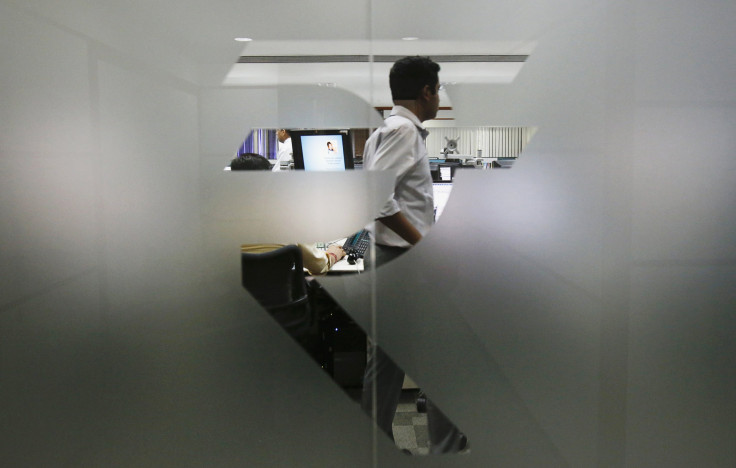Indian Rupee Hits Fresh Record Low Against Dollar, RBI's Liquidity Control Measures, Uncertainty About US Fed's QE Blamed

The Indian rupee continued its free fall on Tuesday, hitting a new lifetime low of 64.13 against the dollar, breaching a previous low of 63.45 set on Monday, while bond yields rose more than 70 basis points and the BSE Sensex fell more than 290 points at the beginning of the day's trading session.
Fear of a capital flight from equity markets over speculation that the U.S. Federal Reserve would begin tapering its bond-buying program sooner than expected, along with India's own deteriorating macro-economic conditions including high inflation, a yawning current account deficit and slowing economic growth, have led to a sharp fall in the value of the Indian currency and local stocks, in recent weeks.
“First, bond yields have been raising in the U.S…the reason is that markets are expecting tapering to happen from the U.S. Fed… which is easily translated into a negative view on emerging Asian debt and currencies. Second factor is current account deficit is really hammering the currencies and stocks,” Varun Khandelwal, managing director at Bullero Capital Pvt Ltd, told International Business Times.
Emerging economies across the world have experienced some capital flight since the Fed announced, a few months ago, that it would wind down its $85 billion-a-month bond-buying program if the U.S. economy began to show signs of a sustained recovery. And, there is growing panic in world markets with more people beginning to predict that the Fed could start scaling down its asset-purchase program as early as mid-September.
"We still expect the Fed to begin reducing its $85bn per month of asset purchases next month," Paul Dales, an economist with Capital Economics wrote, in a research note, on Monday
However, Indian equity markets have been among the worst affected in Asia, because along with global fears about the end of the Fed's stimulus program, India is saddled with its own set of problems such as a high current account deficit, stalled reforms, and growth that has slowed to its weakest in a decade.
And, recent policy moves by the Reserve Bank of India, or RBI, to tighten liquidity in order to save the rupee, which has depreciated more than 15 percent against the dollar in 2013, seems to have backfired and has contributed to more negative sentiment among investors.
“Rupee is getting disproportionately hammered more compared to other currencies because of some of the policies undertaken by (RBI Governor) D Subbarao at the RBI… to tighten liquidity... When you tighten liquidity you strangle growth more than anything else. His bet was that you will get some relief temporarily relief on the currency,” Khandelwal said.
In the last two trading sessions, the rupee has lost more than 3 percent of its value while the benchmark BSE Sensex stock index lost more than 1,000 points, or 5.5 percent.
The RBI had taken a host of measures in July, including placing limitations on foreign fund outflows and raising its interbank lending rates to curb liquidity, while the Indian government had announced a series of measures to curb gold imports, and to improve foreign fund inflows.
Economists believe that unless the country's government adopts pro-growth measures and the central bank improves liquidity in the economy, investors’ confidence in the country will remain negative, adding pressure on the rupee and stock markets, which in turn, will lead to a further worsening of the pace of growth and the current account deficit.
“The reason why investors won’t come to India is not because of 8 percent 9 percent deficit, but it’s because of 6 percent 7 percent growth rates. The minute you tighten up liquidity and jolt the economy, people don’t want to be investing in India any more… Nobody would want to come to a country where currency is depreciating at 2 percent per day and bond prices are going up on a daily basis,” Khandelwal said.
Yet another major challenge before the country is investors’ lack of confidence in the government's policies and measures, as most of the recently announced economic reforms, such as opening up of the retail sector to foreign direct investments, have failed to attract substantial interest. And, with national elections coming up early next year, hopes of more reforms are on the wane.
“On the government front, they really need to get infrastructure moving, need to take pro-growth measures and they need to demonstrate that they are committed to make these measures work on the ground,” Khandelwal said.
In the bond markets, the yield on India’s 10-year government bond has gone up by more than 70 basis points in the last two trading sessions to 9.23 percent -- a five-year high -- leading to fears of a spike in interest rates, which could, in turn, hurt consumer demand for products such as cars and homes.
On Tuesday afternoon, the rupee had recovered to 63.53 -- still weaker than Monday's record low -- while the Sensex had recovered most of the day's losses and was trading flat.
© Copyright IBTimes 2024. All rights reserved.





















